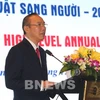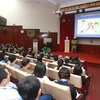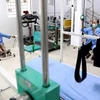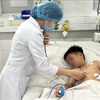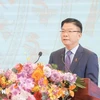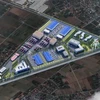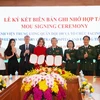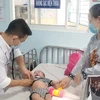Hanoi (VNA) - Thousands of volunteers are working online to help quickly verify information on F1, F2, and F3 cases linked to COVID-19 infections, heard a meeting in Hanoi on February 1 reviewing the work of the COVID-19 quick information response team.
Deputy Minister of Science and Technology Bui The Duy, head of the team, reported that apart from the online group, 100 volunteers are also working directly on-site with the team.
Due to a large number of people travelling from pandemic clusters in Hai Duong to other areas, contact tracing work is facing a lot of difficulties, he added.
He noted that many F1 and F2 cases have used social media to announce their condition, while others have avoided reporting links with infection sources to authorities.
At the meeting, Deputy Prime Minister Vu Duc Dam, head of the National Steering Committee for COVID-19 Prevention and Control, requested people from pandemic-hit areas, particularly Chi Linh city, Kinh Mon town, and Nam Sach district in Hai Duong and Quang Ninh province’s Dong Trieu town, adhere to COVID-19 prevention and control regulations.
Earlier, on January 31 evening, Dam inspected prevention work in Chi Linh and Dong Trieu. He expressed confidence in the containment of the outbreak within the next six days.
Two cases of community transmission were confirmed on January 27 in Hai Duong and Quang Ninh provinces after Vietnam passed 55 days without any local cases. The number has increased rapidly over the last several days, with cases detected in other localities, including Hanoi.
Local authorities and the health sector are implementing drastic measures with the aim of containing the outbreak within 10 days./.
Deputy Minister of Science and Technology Bui The Duy, head of the team, reported that apart from the online group, 100 volunteers are also working directly on-site with the team.
Due to a large number of people travelling from pandemic clusters in Hai Duong to other areas, contact tracing work is facing a lot of difficulties, he added.
He noted that many F1 and F2 cases have used social media to announce their condition, while others have avoided reporting links with infection sources to authorities.
At the meeting, Deputy Prime Minister Vu Duc Dam, head of the National Steering Committee for COVID-19 Prevention and Control, requested people from pandemic-hit areas, particularly Chi Linh city, Kinh Mon town, and Nam Sach district in Hai Duong and Quang Ninh province’s Dong Trieu town, adhere to COVID-19 prevention and control regulations.
Earlier, on January 31 evening, Dam inspected prevention work in Chi Linh and Dong Trieu. He expressed confidence in the containment of the outbreak within the next six days.
Two cases of community transmission were confirmed on January 27 in Hai Duong and Quang Ninh provinces after Vietnam passed 55 days without any local cases. The number has increased rapidly over the last several days, with cases detected in other localities, including Hanoi.
Local authorities and the health sector are implementing drastic measures with the aim of containing the outbreak within 10 days./.
VNA





